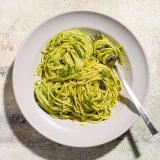With a gentle scooping motion, Antonio Cioffi dredged a spoon over the surface of the... gelato? It curled up, brilliant green, smooth and so luxuriously chilly-creamy I couldn’t help but wonder how heart-stoppingly delicious a spoonful would be. Was it pistachio? Mint? Maybe sweet green tea?
Not quite. Cioffi dropped the scoop into a skillet. As it melted, he added barely tender spaghetti. Flicking the pan back and forth with a practiced wrist, he quickly married the two into a brilliantly dressed pasta. It was not, in fact, gelato. Rather, it was a complete rethinking of pesto—vibrant emerald, deeply herbal and unlike any I’d ever tasted.
I’d come to Ravello—a hillside town on Italy’s Amalfi Coast, where pine trees shaped like hot air balloons and scrubby rosemary bushes the size of cars dot terraces punctuated by churches with bells echoing down to the Tyrrhenian Sea—to learn Cioffi’s modern takes on the region’s classic cucina povera.
That day at his La Vecchia Cantina, we dined on an ancient style of terrine his mother made, various bits of pig boiled until richly savory and sliceable like pie. And on pillowy-tender gnocchi, made with just flour and boiling water, a tradition that dates to a time when even potatoes were considered an extravagance.
But the star was his spaghetti al pesto di prezzemolo, or spaghetti with parsley pesto. Creamy, herbal and rich with hints of briny-savory, it was nothing like the classic pesto Genovese from 1,000 kilometers north, which gets its creamy richness and granular texture from pine nuts and Parmesan. This had neither.
The recipe was simple. Cioffi plunged a whole bunch of fresh parsley into boiling water for mere seconds, then pulled it out and plunged it into ice water. It’s a process that preserves the intense green of the fresh herb. It also breaks down the plant’s cell walls, allowing it to puree more smoothly. This explains the pesto’s exceedingly creamy texture.
Pureed with olive oil, a hint of garlic, a drizzle of colatura di alici—a fermented condiment similar to Asian fish sauce—and a bit of lemon (it is the Amalfi Coast, after all), the result was fresh and grassy, savory and sweet. Tossed with al dente pasta, it tasted of summer in bowl.
As for that gelato? A chef’s trick that proved unnecessary at home. Cioffi goes through so much of this pesto at the restaurant that he prepares it in batches, which he freezes. Home cooks looking to preserve summer’s herbs could, too, of course.
The Creamiest Pesto Has No Cheese, Nuts or Basil!
J.M. Hirsch
Briefly blanching parsley helps it puree into an incredibly smooth pesto.
Photo: Connie Miller of CB Creatives; Styling: Catrine Kelty








